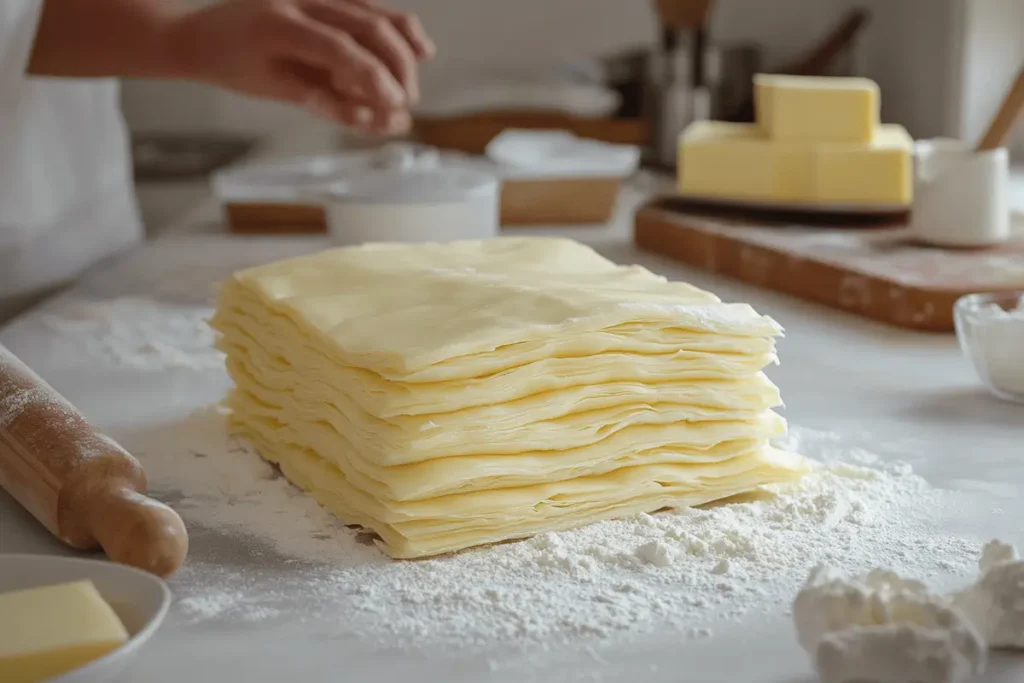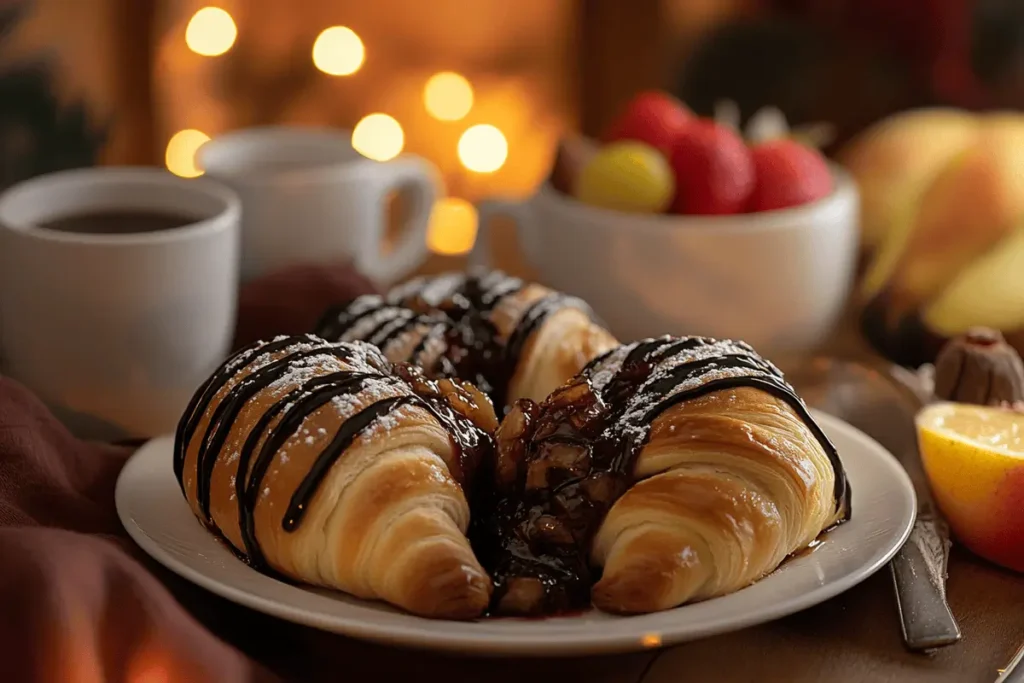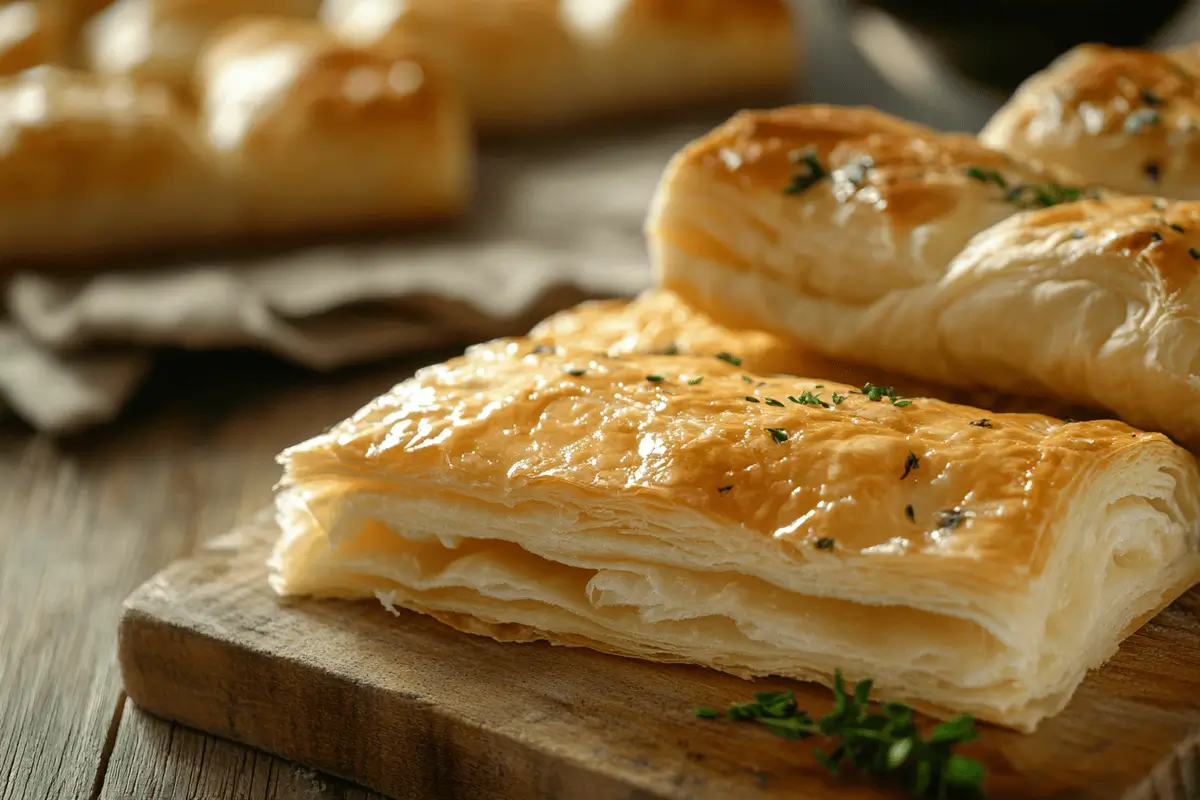When it comes to versatile pastries, puff pastry and crescent rolls are two favorites that often spark curiosity. While both are flaky and indulgent, they have distinct characteristics that set them apart. This article dives deep into the differences between puff pastry and crescent rolls, covering their textures, ingredients, preparation methods, and culinary uses. By the end, you’ll have a clear understanding of which pastry suits your cooking needs and why.
Introduction to Puff Pastry and Crescent Rolls
Overview of Puff Pastry and Crescent Rolls
Puff pastry and crescent rolls might look similar at first glance, but they’re miles apart in structure and preparation. Puff pastry, with its delicate layers and crisp bite, dates back centuries and is a staple in countless recipes worldwide. On the other hand, crescent rolls, known for their buttery softness and crescent shape, have become a beloved choice for quick and easy baking.
Puff pastry is often associated with intricate techniques, while crescent rolls are popular for their convenience and versatility. Both pastries shine in their unique ways, but knowing what makes them different helps you choose the right one for your next dish.
Why Compare Puff Pastry and Crescent Rolls?
Why is it important to distinguish between these two pastries? For starters, their textures and uses vary significantly. Puff pastry is all about lightness and crunch, making it ideal for elegant dishes. Crescent rolls, on the other hand, are soft and bread-like, perfect for casual meals or snacks. Whether you’re crafting a savory appetizer or a sweet dessert, knowing these distinctions ensures your recipe turns out as expected.
What is Puff Pastry?

Definition and Composition
Puff pastry is a laminated dough, made by folding layers of dough and butter repeatedly to create a light and flaky texture. This classic pastry consists of just four simple ingredients: flour, water, salt, and butter. But don’t let its simplicity fool you—it’s a culinary marvel, requiring precise technique to achieve those countless thin layers that make it so airy.
The magic lies in the process. As the dough bakes, the butter melts, releasing steam that separates the layers. This results in the signature puffed and golden finish. Puff pastry is widely used in professional kitchens for its elegant texture and versatility.
Culinary Uses and Versatility
From appetizers to desserts, puff pastry is a star ingredient. It’s perfect for creating delicate tarts, savory pies, and flaky pastries filled with fruit or custard. One of its standout qualities is its adaptability—it can effortlessly transform into a show-stopping main dish or a sweet treat.
For more recipe ideas, consider checking out this crescent roll breakfast recipe guide for inspiration and complementary ideas.
What are Crescent Rolls?
Definition and Composition
Crescent rolls are a softer, more bread-like pastry. They’re made with enriched dough, which includes milk, sugar, and yeast, giving them a slightly sweet and pillowy texture. Unlike puff pastry, crescent rolls don’t require the intricate folding and layering process. Instead, they rely on yeast for leavening, producing a light and tender crumb.
One of the most distinctive features of crescent rolls is their crescent shape. These are commonly rolled into triangles before baking, which gives them their unique form and delightful golden crust.
Culinary Uses and Popularity
Crescent rolls are beloved for their convenience and versatility. Whether used as a base for savory dishes like pigs in a blanket or sweetened with fillings such as chocolate or fruit, crescent rolls are a go-to for many home bakers. Their quick preparation and soft texture make them ideal for casual snacks, breakfasts, and even holiday meals.
To explore how crescent rolls compare to other pastries, you might find this article on crescent rolls vs. croissants helpful.
Key Differences Between Puff Pastry and Crescent Rolls
Texture and Structure
One of the most noticeable differences between puff pastry and crescent rolls is their texture. Puff pastry is all about light, crispy layers that shatter with every bite. This flakiness comes from its intricate lamination process, where layers of butter are folded into the dough. On the flip side, crescent rolls are soft, fluffy, and slightly chewy, with a bread-like consistency. The yeast in crescent roll dough creates its airy crumb, offering a completely different mouthfeel.
For a visual guide to pastries, you can explore this comparison on crescent rolls vs. croissants, which also highlights textural contrasts.
Ingredients and Preparation Methods
The ingredients in these pastries play a big role in setting them apart. Puff pastry uses simple staples: flour, water, salt, and butter. Crescent rolls, however, include yeast, milk, and sugar, making the dough richer and slightly sweet.
When it comes to preparation, puff pastry is labor-intensive. It requires precise rolling and folding to create its delicate layers. Crescent rolls, on the other hand, are much easier to prepare, especially if using pre-made dough. This difference makes crescent rolls more accessible for home bakers looking for convenience.
Culinary Applications
So, what is the difference between puff pastry and crescent rolls when it comes to recipes? Puff pastry shines in sophisticated dishes like vol-au-vents, tarts, and turnovers. It’s often the choice for recipes requiring a flaky crust. Crescent rolls, on the other hand, are perfect for casual meals. They’re ideal for wrapping fillings or serving as a buttery side at dinner.
If you’re seeking inspiration, check out these crescent roll breakfast recipes for sweet and savory ideas.
Frequently Asked Questions (FAQs)
Can Puff Pastry and Crescent Rolls Be Used Interchangeably?
The short answer is: not always. Puff pastry and crescent rolls have different textures and cooking properties. While puff pastry works best in recipes requiring a crisp, flaky finish, crescent rolls are better suited for dishes where a soft, bread-like texture is preferred. Substituting one for the other may affect the final result.
What Is the Shelf Life of Each?
Pre-made puff pastry, when stored in the freezer, can last for several months without losing quality. Crescent rolls, particularly the canned variety, have a shorter shelf life and are best used by their expiration date. Once baked, both should be consumed within a few days for optimal freshness.
Are There Vegan Options for Both?
Yes! Many brands now offer vegan puff pastry made with plant-based fats instead of butter. Vegan crescent rolls are also available, typically made without milk or butter. Always check the ingredient list to ensure compatibility with dietary preferences.
Which Is Healthier: Puff Pastry or Crescent Rolls?
Neither is particularly low-calorie, but crescent rolls generally have less butter and fat compared to puff pastry. If you’re watching your intake, crescent rolls might be the better option, though portion control is key.
Conclusion: Choosing Between Puff Pastry and Crescent Rolls
Summarizing Key Differences
Understanding what is the difference between puff pastry and crescent rolls can help you make the right choice for your recipes. Puff pastry is a buttery, flaky dough perfect for delicate pastries, while crescent rolls are soft, bread-like, and versatile. The contrasting textures, ingredients, and preparation methods make each one unique. While puff pastry is more suited for sophisticated dishes, crescent rolls excel in casual, quick-bake scenarios.
When to Use Puff Pastry vs. Crescent Rolls
The choice between puff pastry and crescent rolls depends on the dish you’re making. Opt for puff pastry when you need an elegant, crispy finish, such as in tarts, turnovers, or vol-au-vents. Choose crescent rolls for their ease and softness, whether you’re wrapping savory fillings or creating a quick breakfast treat. By knowing their strengths, you can enhance your culinary creations and pick the pastry that best fits your needs.
Additional Culinary Applications of Puff Pastry and Crescent Rolls
Both puff pastry and crescent rolls offer a world of possibilities in the kitchen, making them essential tools for home cooks and professional chefs alike. Let’s explore the numerous ways these pastries can be used to create impressive dishes, from savory snacks to indulgent desserts.
Savory Applications of Puff Pastry
1. Appetizers and Finger Foods
Puff pastry is a go-to choice for bite-sized appetizers. Its light, flaky layers elevate any dish, turning simple ingredients into something extraordinary. Popular examples include:
- Savory Tarts: Create mini tarts with toppings like caramelized onions, goat cheese, or roasted vegetables. The crispy pastry base adds texture and richness to every bite.
- Cheese Straws: Twist strips of puff pastry with cheese and seasonings, then bake until golden. These are perfect for snacking or serving at parties.
- Stuffed Pastries: Fill puff pastry squares with ingredients like spinach and feta, mushrooms and garlic, or chicken and herbs, then fold and seal into pockets.
2. Pies and Savory Pockets
Puff pastry excels in savory pies, thanks to its ability to provide a buttery, crispy crust. For example:
- Chicken Pot Pie: Use puff pastry as the top layer of a hearty chicken pot pie for a flaky, golden finish.
- Empanadas and Hand Pies: Shape the dough into pockets and fill them with spiced meat, vegetables, or even legumes for a vegetarian twist.
Savory Applications of Crescent Rolls
1. Quick and Easy Meal Bases
Crescent rolls shine in recipes where convenience meets creativity. Their soft, bread-like texture makes them ideal for quick, satisfying meals.
- Savory Roll-Ups: Roll crescent dough around fillings like cheese, deli meats, or roasted vegetables. These are great for lunchboxes or quick dinners.
- Mini Pizzas: Flatten the dough, top it with marinara, cheese, and toppings, and bake for an easy homemade pizza.
- Wrapped Entrées: Use crescent rolls to encase sausages, chicken breasts, or veggie patties. The dough bakes into a buttery crust that complements the savory fillings.
2. Casseroles and Layered Dishes
Crescent rolls can be used to create layered casseroles or as a topping for baked dishes.
- Breakfast Casseroles: Layer crescent dough in a baking dish with eggs, cheese, and breakfast sausage for a comforting morning meal.
- Savory Cobblers: Use crescent dough as a quick topping for baked casseroles like pot pie or a Tex-Mex-inspired chili bake.
Sweet Applications of Puff Pastry
1. Elegant Desserts
When it comes to desserts, puff pastry delivers an air of sophistication. Its crispy layers and buttery flavor make it the ideal canvas for countless sweets.
- Mille-Feuille: This classic French dessert features layers of puff pastry and pastry cream, topped with a sugar glaze or powdered sugar.
- Fruit Tarts: Fill a baked puff pastry shell with custard or cream and top it with fresh fruits for a light, colorful dessert.
- Palmiers: Roll the dough with sugar, cinnamon, or chocolate, then slice and bake to create crisp, heart-shaped pastries.
2. Pastry Shells and Vol-au-Vents
Puff pastry shells are versatile for both savory and sweet fillings. For desserts, fill the shells with mousse, whipped cream, or fruit compote. The crisp layers provide a delightful contrast to the creamy fillings.
Sweet Applications of Crescent Rolls

1. Comforting Breakfast Pastries
Crescent rolls are often used for simple, comforting breakfast treats. Their slightly sweet, buttery flavor pairs perfectly with morning coffee or tea.
- Stuffed Crescent Rolls: Fill the dough with Nutella, cream cheese, or fruit preserves, then roll and bake for a quick breakfast treat.
- Cinnamon Rolls: Transform crescent dough into cinnamon rolls by adding sugar, cinnamon, and butter before rolling and baking.
- Fruit-Filled Crescents: Wrap crescent dough around slices of apple, pear, or banana, then sprinkle with cinnamon sugar for a quick and easy dessert.
2. Easy Desserts for Busy Bakers
Crescent rolls are a lifesaver when you need a dessert in a pinch.
- Chocolate Crescents: Simply wrap crescent dough around pieces of chocolate and bake for a gooey, indulgent dessert.
- Turnovers: Fill the dough with fruit preserves, fold into triangles, and bake until golden. Drizzle with glaze for an extra touch of sweetness.
- Monkey Bread: Use crescent dough as the base for pull-apart monkey bread. Coat pieces of dough in cinnamon sugar, stack them in a pan, and bake for a shareable treat.
Fusion and Innovative Uses
Both puff pastry and crescent rolls lend themselves to creative, fusion-inspired recipes. Here are a few innovative ideas to try:
- Puff Pastry Sushi Rolls: Use baked puff pastry to wrap around seafood, avocado, and rice for a unique twist on sushi.
- Crescent Dough Waffles: Cook crescent dough in a waffle iron for a crispy, layered take on traditional waffles.
- Savory Eclairs: Use puff pastry instead of choux for savory eclairs filled with cheese or vegetable mousse.
Choosing the Right Pastry for Your Recipe
Knowing what is the difference between puff pastry and crescent rolls is crucial when selecting the right dough for your dish. Puff pastry is best for recipes requiring lightness and crispiness, while crescent rolls are ideal for soft, comforting dishes. Understanding their unique properties will ensure your culinary creations are both delicious and well-suited to the occasion.
For more recipe ideas, explore this guide on crescent roll breakfast recipes to find inspiration that complements puff pastry dishes.

